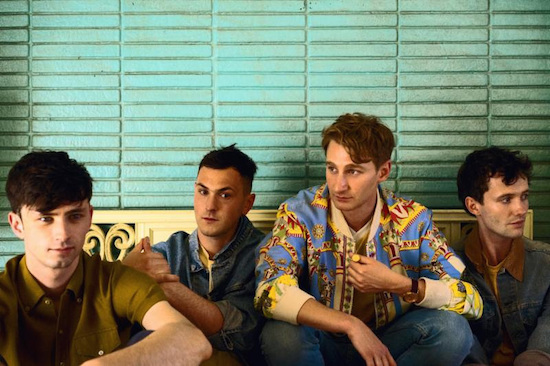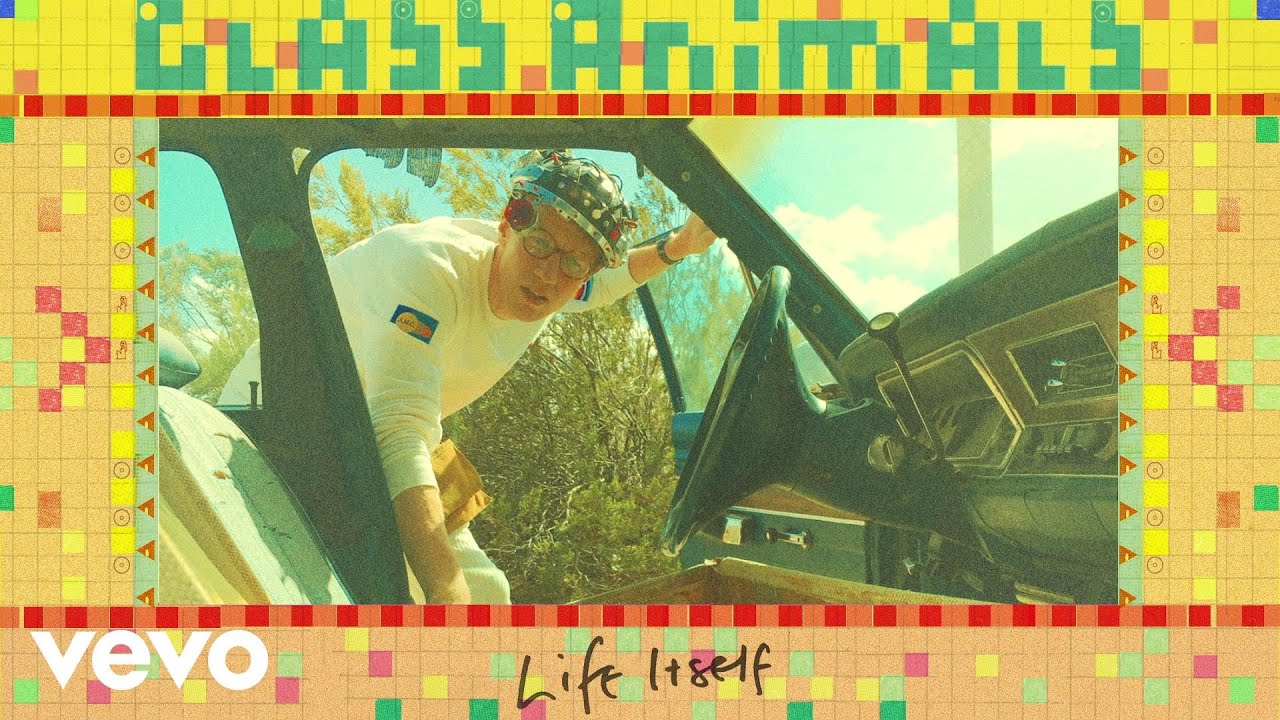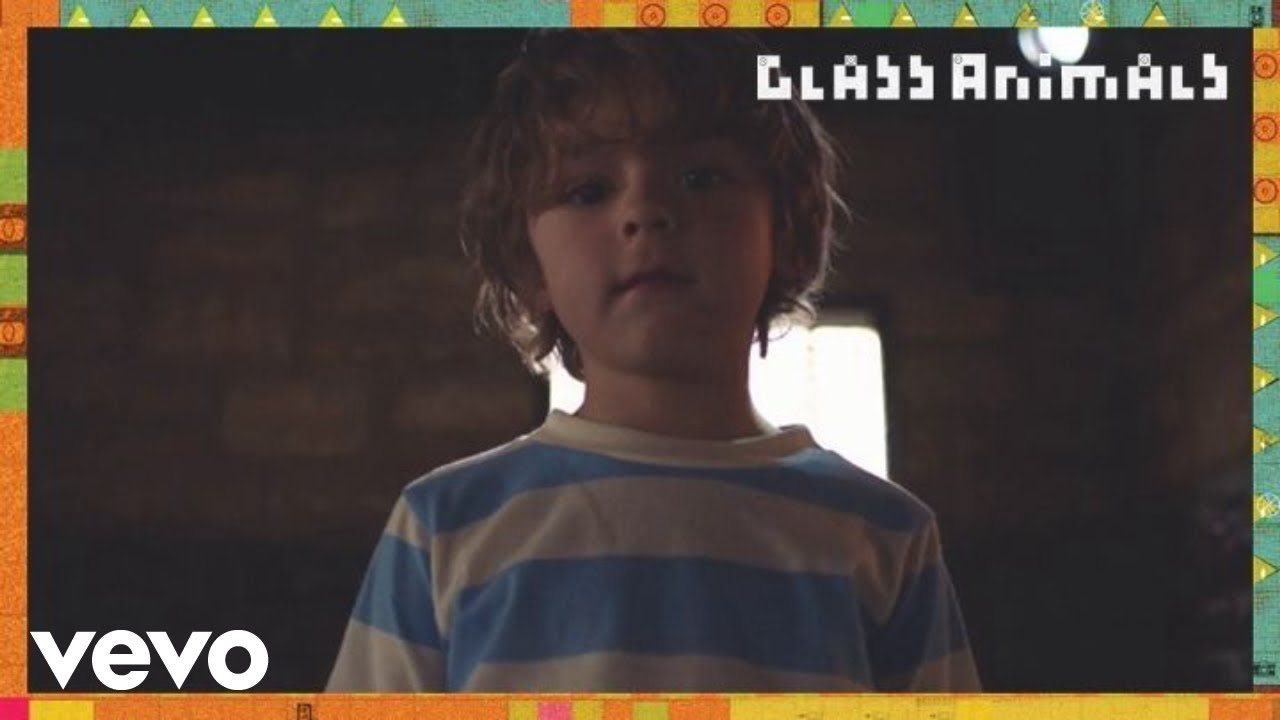Glass Animals are far more than first appears. At first glance, the Oxford foursome’s new album How To Be A Human Being is a slick listen of lush, accessible alt-pop, and an outstanding one at that, yet even beyond the music’s vast layers of texture there’s an overwhelming amount more to explore.
Inspired by the documentary vignettes of Les Blank and Erol Morris, Jim Jarmusch’s One Night On Earth, and by secret recordings of strangers’ tall tales and anecdotes collected on tour, each song on the album has its own protagonist, a cast of characters lead writer Dave Bayley fleshed out with a novelist’s fervour when approaching his lyrics. He would set out their personality, backstory, fetishes and favourite foods before a note was struck, then surrounded them once more with a rich vein of complementing references from LCD Soundsystem to T.S. Eliot, photographing actors in painstakingly designed ‘sets’ for the record’s artwork.
For some characters entire websites even exist, although as drummer Joe Seaward insists, “We didn’t create them, the characters did.” Bayley’s eyes light up to a blaring chiptune version of ‘Life Itself’, the record’s opener and first single, as he fires up raygun123.com. The track and accompanying video concern a lonely sci-fi obsessive who still lives with his mother, and his website comes loaded with an entire short story, three games, a Google Maps-based alien conspiracy, and a family tree accessible only to those with the correct ‘documentation’. dizzyoncaffeine.com meanwhile, which accompanies ‘Youth’, is a different beast entirely, though no less fully formed, an achingly modish Tumblr resplendent in pastel-shaded vintage imagery.
The sheer creative depth of Glass Animals’ latest project is, in short, astounding and it’s to their further credit that the finished article remains laden with such distinctive wit and personality. Though stuffed to the brim with countless allusions, How To Be A Human Being remains at all times an unabashed pop record that’s never bogged down in a pretentious mire of its own influences. “I like pop music. There’s an amazing simplicity to pop music that allows you to hear it once, that’s what we’re trying to do,” says Bayley, “there’s equal beauty in the simplicity of things.”
What is it about fleshing out the characters in your songs to such a huge extent that feels so important?
Dave Bayley: To start with, it has a huge effect on the music. After writing the lyrics I would start developing the characters a bit more, what kind of person they might be, then that automatically allows you to start writing music that would work for them. For instance in ‘Life Itself’ the character is a bit of a sci-fi geek, so the chords are like weird sci-fi theme chords.
When you’re writing music you know it fits with the character, then that in turn allows you to make artwork that fits for that character. We took those documents and built a ‘set’ for each character. For him he lives in his mum’s living room, and we photographed him in there. We chose the wallpaper, chose the furniture, and sat him down. It made the video super easy because everything was already there, everything was written down.
Joe Seaward: It made the writing process really streamlined, having something in the distance to aim toward meant that ideas that didn’t fit were like putting a square peg in a round hole, whereas otherwise you wouldn’t know what shape you’re putting it into. The more clearly defined that is, the more detail there is with the character, the easier it is to feel what works.
There’s so much going on beyond just the music on this record, why did you decide to take it that step further with the artwork and websites?
DB: Well, people used to buy vinyl and CDs, and with that you get context, lyrics, everything. You learn about the musicians, and you don’t get that anymore on digital.
So you’re reacting to that deliberately?
DB: That’s kind of the idea. I have no idea if it’s successful or if it’s fucking dumb. I like to think all artists could someday release something along with their digital records.
JS: If they want to.
DB: But I hope they do, because I hate it if I’m listening to someone’s record and I can’t find anything about it apart from this 160 X 160-pixel image on iTunes.
JS: I think it’s just another way of giving some context to this idea that exists. It’s there if you want it but completely ignorable if you don’t. I think that’s the thing I like about it, it genuinely only exists for people that want to find it. It’s like a treat for anybody who cares enough.
How was your creative process different to the first album?
DB: It was the opposite. On the first record we started with just electronics, with the beats and the production because it felt very natural. Then this time round we looked back at the other record and realised it was quite abstract, and that the lyrics were hard to get into.
I wanted to write this record about people, and that had to be the opposite, it had to be down to earth, these people had to be relatable, they had to be very real. So I wanted to actually start with the lyrics, and the production came last. It kind of made it so much easier to do the music, you know what the characters are like so you know what the sounds are like.
You’ve talked about how taking secret recordings of strangers’ anecdotes and conversations were integral to the writing process, in what way did you actually use these during the creation of the record?
DB: We were meeting so many people on tour and we wanted to remember all these stories people were sharing, secretly. Then last winter we listened back to all these recordings and started to notice things about the way that people tell you stories, what people say, what people might have left out, what they might have exaggerated. It might just be total bullshit, but all of that means something about them – there’s a story behind the story, what that says about their life.
I thought that was all really interesting, weird levels going on, then I thought it would be interesting to make up more stories on a third level, like me writing a character. There were some amazing stories… some that were just so sad, really heart-breaking moments.
Are there any in particular that stood out?
DB: There was one guy, a taxi driver in New York. We drove past a club and he said ‘I’ve got a story about that club’. He said he was in love with this girl, absolutely obsessed with her. He would always ask her out and she would always say no, then eventually she said yes. He went on a double date with her and his best friend and his girlfriend. They went out to this club, danced and had an amazing time. He was in love, happy and giddy, and they went back to the car. His best friend and his girlfriend started making out in the front seat, and he was in the back with this girl, he was so happy this date had gone so well. Then while they were kissing in this car someone came up and tapped on the windscreen. Everyone looked up and then the guy at the window pulled out a gun and shot the two people in the front seat, then pointed the gun at him and pulled the trigger, and it just goes ‘click’. He was out of bullets and ran away.
JS: Apparently the guy was a serial killer, he’d gone around killing people, couples. He’d walked across the street before and they’d clocked him and didn’t think anything of it, then he came back across the street and… did it.
So when you’ve got such intense stories like that on record, how would that inform your songwriting?
DB: I guess it’s the emotion of it all. This guy was overwhelmed with young love, giddiness for one second, then his world was turned upside down the next. You have to imagine how he must feel, then you take that emotional sentiment, how it must have affected his life, and kind of push that into another character. There are loads of stories like that, you have to take the emotion, what that person must have felt, and try and apply it.
Around the time of your last album, Zaba, you spoke a lot about influences from other art too, from books like Heart of Darkness and The Island of Dr. Moreau, which seemed like a very important part of the development. Is that still true this time around?
DB: That definitely happened on this record, I rammed it full of weird references to everything I’ve ever read, weird sixties sci films, cartoons, my favourite poems, favourite books, it’s all in there lyrically and with some musical references as well, nicking cheeky things from my favourite songs.
But at the same time, musically, the record isn’t stuffy or pretentious, it feels accessible. Was that something you were intentionally trying to make sure of?
JS: One of the things that we try to do is to allow the music to be superficially something that could be absorbed by people on a basic level, like ‘this sounds nice’ or ‘sad’ or ‘fun’, or whatever. But also, whilst that was going on, there’s all this detail that Dave went into writing the characters, the artwork that goes along with it. If people want to, hopefully we’ve allowed enough space for people to invest time into it, which is what those references are.
If you want to find out more, like ‘why is this character like this? Why is there a person that lives at home with his mum? How did he get there? What is he like?’ well now there’s a weird website that you can get lost in, and there are these samples in the songs and things in the lyrics that mean things in relation to the character. If you want to learn more and invest time, get lost in this little web, or it can just be something you can take in and enjoy on a surface level then leave it at that.
The video for ‘Life Itself’ fits into the wider project too. How much of a hand do you have in your videos?
DB: It really depends, but I do really like the idea of getting someone else’s interpretation of the song. Music videos should never be taken as the definitive explanation of the song, though sometimes people do take it like that, but in this case we happened to be around for the shoot. We were there throwing ideas back and forth with Neil the director, and we handed over all these documents about the character, what they eat, what their fetishes are, and handed that all over to him for the character of ‘Life Itself’. We sort of came up with a ‘plot’.
When does writing the actual music come in to the process?
DB: The music does come quite quickly afterwards, sometimes at the same time. Sometimes the melody comes with the lyric, and then I guess I came off tour and locked myself in a studio for about a week in a half then came out with demos for pretty much all of the record. It was a sleepless week and a half, then I brought the demos to the guys and we started prying them apart. I was so close to [the songs] at that point they could point out the weak links. Sometimes we end up completely changing a song, sometimes we go back to the demo. ‘Youth’ is just the demo, even though we tried really hard to tear it apart and put it back together again.
Did any conversely change completely?
DB: Yeah, ‘Life Itself’ was originally quite angsty.
JS: It was this little ball of fidgety scariness. We tried to have a fiddle around at the very start and then benched it, then came back, then benched it again and came back again, then one day it cracked, like it had split in half and this thing came out that was really satisfying. What was fun about it is that Dave would come with this thing, and we would just chuck everything at it, more hooks, different chords, percussion, and some of it would stick and some of it wouldn’t.
After the success of your first album and tours, you’re performing to larger and larger audiences, has that changed the way approached the studio?
JS: I wouldn’t say we’ve changed anything in the studio or in the writing process to be geared towards anything that happens live. We try quite hard to make the record as good, as quiet or as hard as it needs to be, for itself. The live thing is the other sphere that we exist in. Translating the record to live is a really fun part of our job, because it’s not easy to do.
One thing that playing live a lot did do was make me realise that there’s certain things people react to; you can play with people’s expectations in a way that means you don’t have to turn everything up to full volume all the time. You can take a song down in tempo and atmosphere so that when a song that’s faster and more lively comes in it doesn’t have to be so hard that it knocks people off their feet, because the difference between those two things is enough.
You’re playing the Roundhouse in October, your biggest headline set to date, is that something that’s daunting or something you’re looking forward to?
DB: Playing in London’s always a bit frightening for me because it’s where friends and family are actually from, it’s where we grew up watching music – Oxford and London – so it’s got that cultural significance for me. But it’s good scary, rather than ‘fuck’ scary. It’s one of those places you’ve seen your favourite bands play, it feels weird we’re doing it too.
How To Be A Human Being is out now. Glass Animals play London’s Roundhouse on October 25. You can buy tickets here




